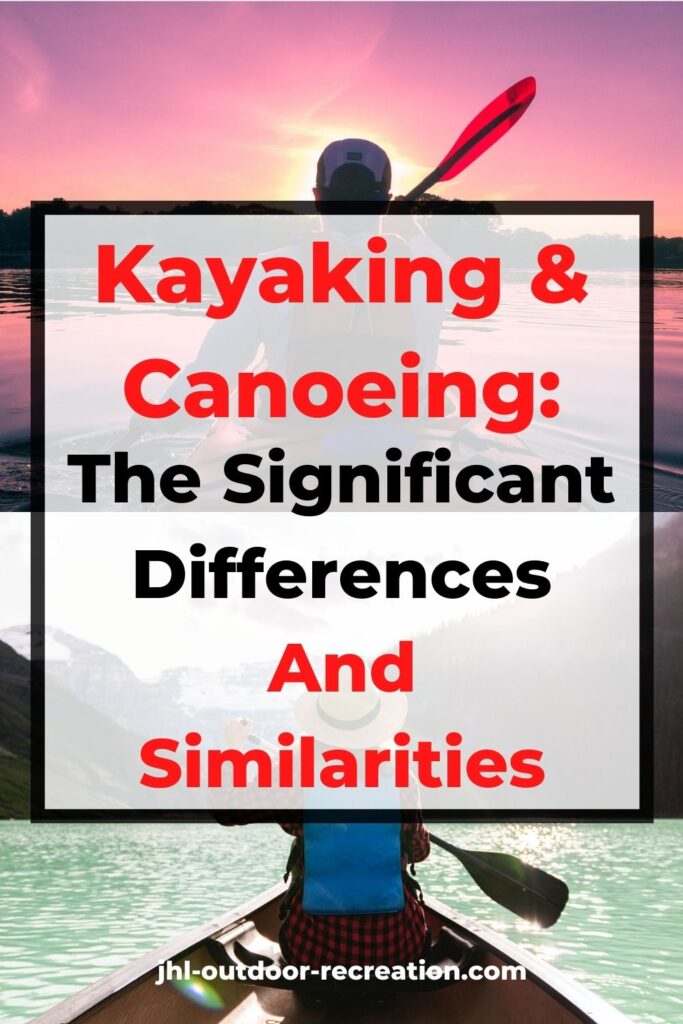By looking at the words, we know, sorta, the differences between kayaking and canoeing.
But, I remember when I watch the Summer Olympic Games, kayaking is under category of CANOE SPRINT. So, I wonder whether kayaking is actually the SAME as canoeing or not.
In fact, some people thought both terms are interchangeable, as they look quite similar. Plus, both kayaking and canoeing can either be outdoor recreational activities or water sports.
So, what are the differences between kayaking and canoeing? And, are there any similarities between these two activities?
Hence, we are gonna discuss both the similarities and differences between kayaking and canoeing, and this MIGHT be a reference for you to choose which one is preferable for you.
1. Differences
There are 10 distinct differences between kayaking and canoeing.
1.1 Vessel
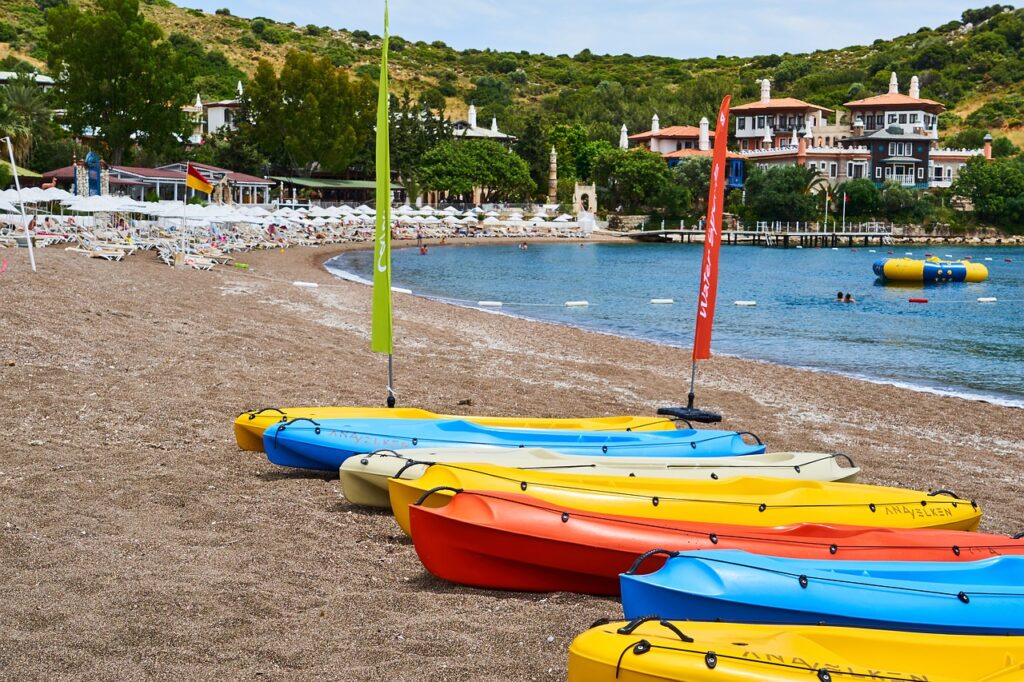
As the names suggest, KAYAK is for kayaking and CANOE is for canoeing. – So, these are the names of the respective vessel.
If we watch Canoe Sprint in either Olympics or other competition, we’ll notice kayak and canoe are in fact quite similar. – Some people may not be able to notice the difference and think both kayak and canoe are the same!
In fact, vessel is the fundamental difference between kayaking and canoeing. The difference is very obvious if you observe this from the recreational point of view.
Kayaking
A kayak has a CLOSED cockpit (except for Sit-On-Top kayak) and the body of the kayak is lean and narrow. There are covered storages available at the bow and the rear of kayak.
A seat on a kayak is a must for both Sit-On-Top and Sit-Inside Kayak, and usually we can adjust the seat to have a proper sitting posture while paddling.
And, the paddlers can use SKIRT to conceal the cockpit when paddling, so that they minimize the chance of getting wet. – A privilege which is not available for a canoe.
Kayak is relatively lighter than canoe because of its DESIGN and MATERIAL. So, most of the time, a single person can lift and carry a kayak without having any issue. – This makes transporting a kayak relatively simple and convenient.
Canoeing
A canoe has OPENED cockpit and the body of the cane is wide. Since the body of a canoe is much larger than a kayak, the middle part of the canoe is a PERFECT space to put anything you want. – This is a privilege which is not available for a kayak.
As opposed to a seat in a kayak, seating benches are available towards the bow and the rear of the canoe.
However, the opened cockpit is also the biggest disadvantage of a canoe because paddler can easily get wet when canoeing, unlike a kayaker can use a skirt to minimize the splash of water when paddling.
Apart from this, a canoe is heavier than a kayak and usually, it takes more effort to transport the canoe.
1.2 Kayaking and canoeing paddle

The paddles of kayaking and canoeing are very distinctive.
Kayaking
Double-Bladed paddle. We can actually dismantle or rejoin the paddles via the FERRULE. There are 2 types of paddles, ie. FEATHERED paddles and UNFEATHERED paddles.
An unfeathered paddle is each side of the blade is symmetrical to each other, so it is easy and straight forward to grip.
A feathered paddle allows the paddler to OFFSET the angle of the paddle via the ferrule as well, so that either side of the blade is tilted to certain angles to the other side of the blade. – Usually the offset angle is between 30 to 60 degrees.
Although it is tougher to use the feathered paddle, it actually fits better than an unfeathered paddle, as it is more aerodynamic and ergonomic. – As we have both dominant and non-dominant hand.
So, we can feather the paddle according to our dominant side. Hence, we have both LEFT feathered and RIGHT feathered paddles.
Canoeing
Single-Bladed paddle. The paddle consists of a grip, shaft and a blade. There are 2 types of paddle, which are STRAIGHT shaft paddle and BENT shaft paddle.
Although we couldn’t offset the angle of the paddle like the double-bladed paddle, the bent shaft paddle is an ergonomic-designed paddle which OFFSETS the paddle at certain degree.
The bent paddle makes paddling more efficient by catching more water and reducing fatigue while paddling.
Plus, there are 2 types of grip in canoeing paddle, ie. T-grip and palm grip. This provides options to choose which grip is better for the paddler, depending on the individual preference.
1.3 Posture of kayaking and canoeing
Posture while kayaking and canoeing is one of the crucial factors when it comes to paddling. The correct posture provides comfort, stability and efficiency.
Kayaking
SITTING is the only posture. Sitting while kayaking, however, is not as mundane as sitting on a chair while watching video or working.
In fact, sitting places an important role in kayaking. The paddler needs to sit in a NEUTRAL position, which is sitting straight but also relaxed. This helps achieve a better range of motion when paddling.
Canoeing
There are options to either “SIT” or “KNEEL”. Similar to kayaking, sitting while canoeing provides great comfort. – I mean, who doesn’t like to sit while canoeing and enjoying the surroundings?
But, why do people choose to kneel while kayaking? – In fact, kneeling provides greater stability than sitting while canoeing.
This is because while kneeling, the centre of gravity of the person is lower than the person who is sitting. Plus, your thighs become the TRIPOD and this essentially forms a stronger base. So, this helps the paddler position himself better while turning.
Furthermore, kneeling also provides better range of motion while paddling. This allows the paddler to reach and place the paddle further and so able to catch more water.
The efficiency is even more enhanced when the paddler Kneel On One Foot. That is why those professional canoers adopt this posture while paddling.
1.4 Position when kayaking and canoeing
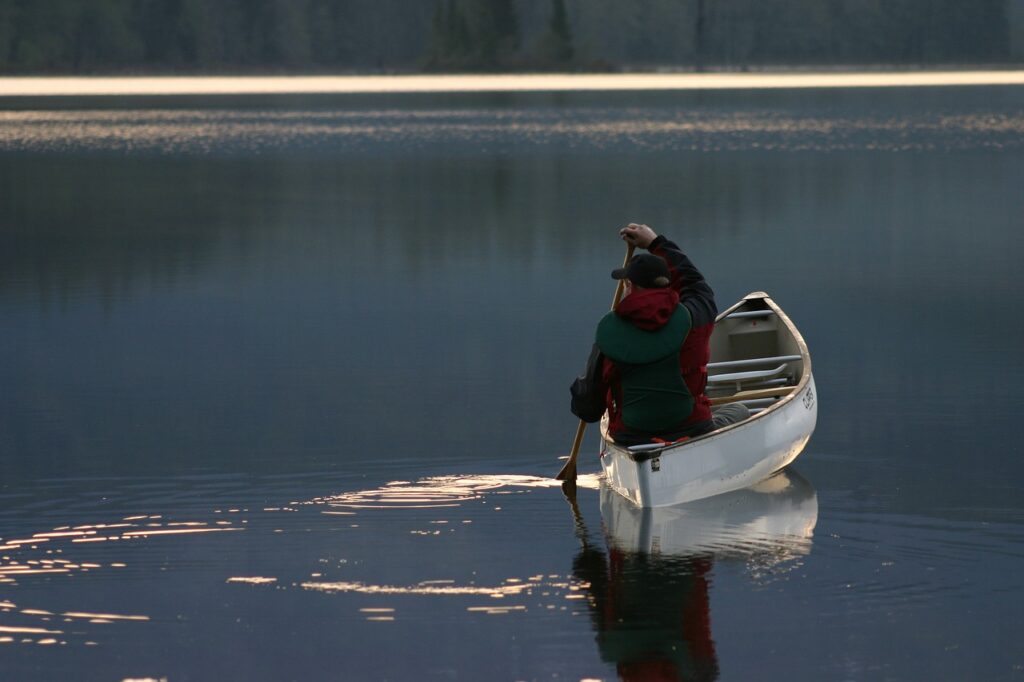
Similar to posture, position of sitting or kneeling is also very crucial in kayaking and canoeing.
Kayaking
The paddler has to sit at the centre of the kayak. This makes sure the kayak is BALANCED so that the kayak is in a stable position.
Also, sitting at the centre of the kayak allows balanced paddling.
Canoeing
The paddler can either choose to stay in the middle or lean to one side of the canoe. Similar to kayaking, sitting in the middle of the canoe allows a balanced position on the canoe.
Notwithstanding this, many paddlers choose to lean to one side of the canoe. – But, why do they want to sit like that? Shouldn’t be the canoe not balanced anymore?
Yeah. This position exactly makes the canoe tilt to one side. But, unlike kayak, canoe has greater stability which can counter this issue (in the section below).
Leaning to one side, in fact, makes the paddler have better control of paddling, so that they don’t have to waste additional effort to reach the water when paddling. – So, this is a great position for recreational canoeing.
1.5 Stability of the vessel
The stability is highly dependent on the WEIGHT and DESIGN. As discussed above, as a canoe is bulky and heavy, it has greater stability than a kayak.
That is why when a paddler chooses to lean to one side of the canoe when paddling, the canoe is still in a stable position, despite the tilt of the canoe. This won’t happen in kayaking as the paddler can easily lose his balance if he leans to one side of the kayak.
Even when capsizing happens, it is easier for the paddler to escape from the canoe, so that they are not trapped inside the canoe. – This, however, also applies to a Sit-On-Top kayak.
A kayak, on the other hand, is lean and light, so the stability in the water is not as good as a canoe. For a Sit-Inside kayak, there is a chance where the paddler is trapped inside the kayak when capsizing happens.
In fact, there is a special and advanced drill for the paddler to roll the flipped kayak back to its original position.
However, both canoe and kayak are stable vessels and the chance of capsizing is really remote. In fact, the kayaker can learn how to lean and edge the kayak properly so that he knows how to balance the kayak when paddling.
1.6 Speed of kayaking and canoeing
This is a concern when choosing between kayaking and canoeing to be a suitable activity for you.
Again, the general speed of kayaking and canoeing varies and are distinctive to each other, depending on WEIGHT and DESIGN.
SPEED is the trade-off for stability. – Meaning, the greater the stability is, the slower the speed.
Let’s understand both kayak and canoe. A kayak is light, lean and narrow, which has smaller momentum and makes a better hydrodynamic movement through the water.
A canoe, on the other hand, is heavy and bulky. This makes a canoe has greater momentum, which makes it harder to move through the water.
Actually, the speed of kayaking is further enhanced by the way of paddling in both kayaking and canoeing. We are gonna cover this in detailed in the section below.
How much is the speed difference between kayaking and canoeing
Let’s look at the record achieved of the respective categories in Summer Olympic in 2016. Under K-2 1000M (Kayak Double) Men, the result of gold medalists is 3:10.781; Under C-2 1000M (Canoe Double) Men, the result of gold medalists is 3.43.912.
So, there is around 33-Second slower in canoeing. Meaning it is roughly 17.4% slower in canoeing. – Well, this is just a rough calculation to get the idea that kayaking generally is faster than canoeing.
1.7 Paddling of kayaking and canoeing
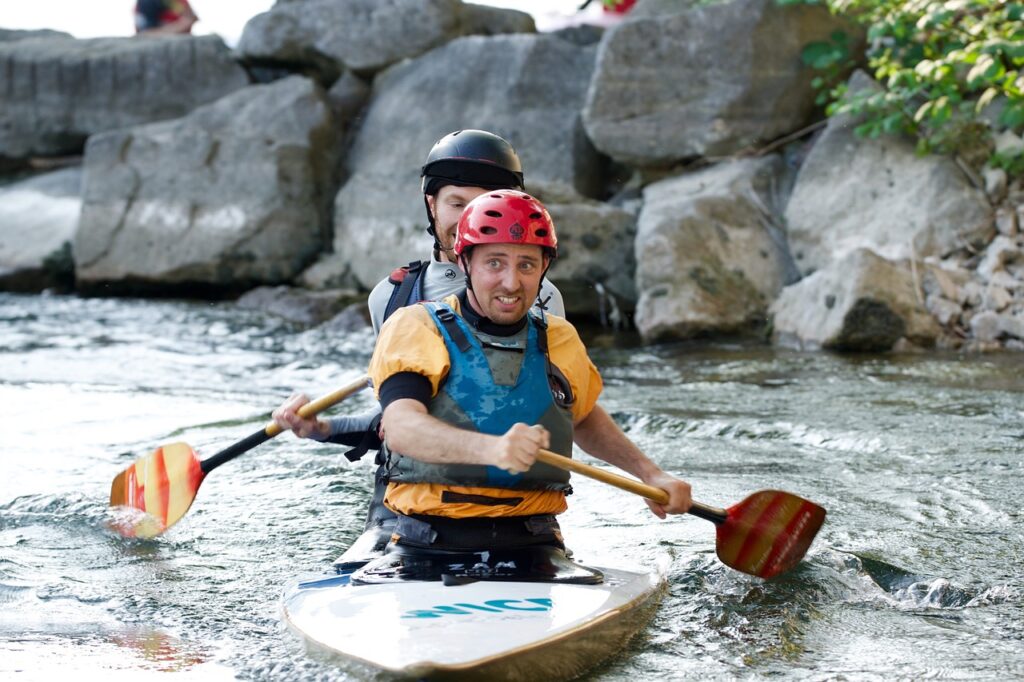
Many people believed that kayaking and canoeing are arm-dominant activity. So, we need to paddle as hard as we can in order to paddle fast.
However, their belief is not fully correct. In fact, both kayaking and canoeing heavily rely on the CORE ENGAGEMENT. – So, we need core strength to paddle efficiently.
But, there is slight difference between kayaking and canoeing when it comes to core engagement.
Kayaking
Rotation is the key. To be able to paddle efficiently, the paddler needs to rotate his body, so it is not just relying on his arm to “swing” the paddle. – Paddling with a stagnant body is a big No No!
People also perceive that “pulling” is all we need while paddling. In fact, we need to consider both “pushing and pulling” in order to paddle efficiently. – How to do this?
Well, notice when a paddler is PULLING the paddle on one side, the torso need to rotate so that body and the hand of the other side PUSH the paddle simultaneously.
Canoeing
Paddler has a dominant paddling side. So, the paddler will always paddle on his DOMINANT SIDE. The paddler may switch to the other side in occasions where he is tired from paddling on his dominant side or he needs to change the direction.
How to make sure the core is engaged while paddling?
Notice the form of the paddler before the paddle enters the water. It forms an “A” alphabet between his body and the paddle.
Once the paddler starts to paddle, the paddler should use the torso to draw the paddle. The hand on the grip should “push” and the hand on the shaft should “pull” the paddle simultaneously. Rotate the torso while paddling.
By doing this way, it can greatly reduce the load of the arm and hence reduce arm fatigue.
1.8 Forward stroke
Both kayaking and canoeing also rely on forward stroke to propel forward. Of course, this is the main stroke in both kayaking and canoeing.
But, for technique wise, they are different.
Kayaking
If your technique is not strong, it is very easy to navigate the kayak in a “zigzag” pattern. Or, the kayak can tilt and move to one side.
To have a good forward stroke, each side of the paddling has to be symmetrical, in terms of strength and pattern. – Simply said, the left hand side is equal to the right hand side.
A paddler has to control the strength of his dominant side or improve the strength of his non-dominant side. Or, the angle of placing and drawing the stroke is symmetrical. – If otherwise, the paddle might use “sweep” stroke on one side and “forward” stroke on the other side.
Canoeing
If you think moving in a straight line in kayaking is difficult, then I have a bad news for you. Technically, paddling in a straight line in canoeing is more difficult than kayaking. – Yeah, because of the one-side paddling.
But, how do the paddlers move in a straight line? The most common stroke to navigate in a straight line is J Stroke.
Imagine a paddler paddling on the right side. The paddler pulls the paddle as usual. Once the paddle reaches the position behind the paddler, the paddler rotates 90 degree his left hand on the grip downward, so that the thumb faces the water.
The rotation also causes the blade changes its direction, parallel to the canoe. There is a little pause here to allow the canoe realign to straight line. Then, the paddler lifts the paddle and the paddle exits the water.
Essentially, the paddler is drawing a “J” alphabet for the whole forward stroke. – Here comes the name “J Stroke”.
There are other types of strokes, however, used to navigate the canoe in a straight line, such as Canadian Stroke or C Stroke. In fact, these are the variations of J Stroke which they work about the same as J Stroke.
1.9 Synchronization
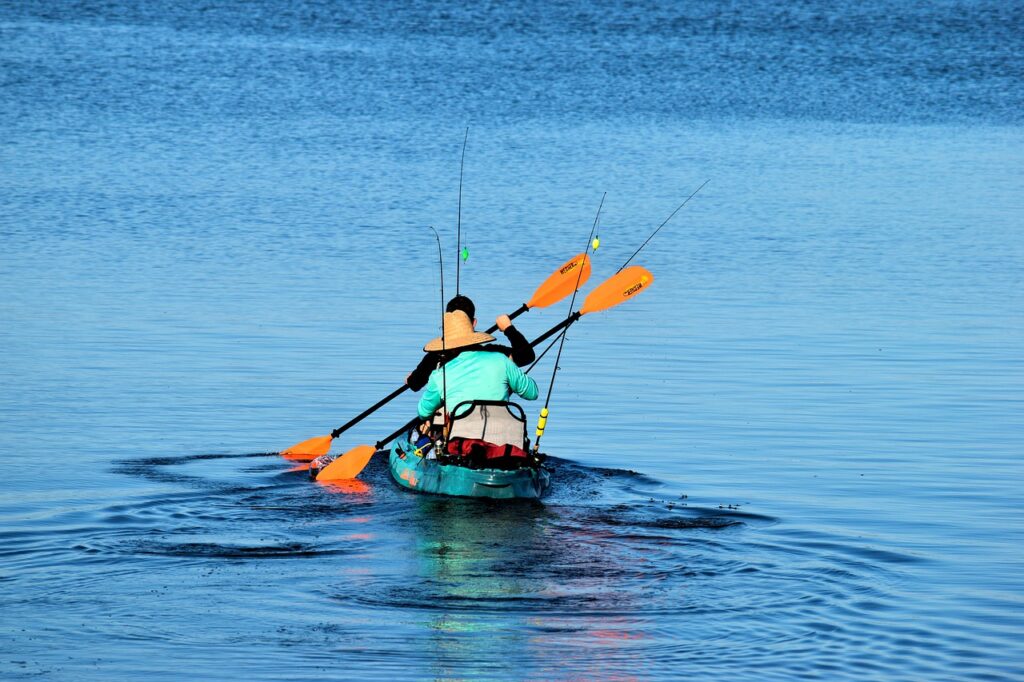
This applies to NON-SOLO kayaking and canoeing. The partners have to be SYNCHRONIZED to have efficient paddling. However, the context of synchronization in kayaking and canoeing is slightly different.
Kayaking
The paddling of the partners needs to be IDENTICAL. This includes the timing of movement and pattern in every phrase of the forward stroke. – Same principle as marching.
Canoeing
Firstly, they should have BALANCED number of left and right dominant paddlers.
For example, for 2-people canoeing, they are both 1 left-dominant and 1 right-dominant paddler. Likewise, for 4-people canoeing, there are both 2 left-dominant and 2 right-dominant paddlers.
The placement of the paddler is also important for 4-people canoeing. For example, it cannot have both left-dominant or right-dominant paddlers in the middle of the canoe. The sequence needs to be in reciprocal.
The timing of the movement and pattern of the stroke must be in sync. So, essentially, the paddlers are MIRRORED to each other.
1.10 Purpose of kayaking and canoeing
Both kayaking and canoeing are suitable for recreational and sport purposes. But, when it comes to recreational purpose, there are subtle differences between kayaking and canoeing
So, if you are thinking whether you prefer kayaking or canoeing, then you need to further assess the purpose of each option.
Individual vs Family
The size of the vessel places a great influence here. As mentioned above, a canoe is an open cockpit and the space is really big. Plus, a canoe is heavy, which means canoe is slower than kayak when moving through the water.
Because of this, canoeing is a perfect water activity for a family as the family members can all sit inside the canoe. Slow-paced moving enables the family members to enjoy and observe the surrounding and to have more quality time amongst the family members.
Thus, kayak is a better option for individual or pair because of the restriction of having more people inside the kayak. Also, they can enjoy themselves while focusing on paddling or observing the surrounding.
Sub-activity
Apart from paddling, if you want fishing, reading books or even to have a picnic, then you should consider canoeing! You’ll appreciate the privilege of the big space of a canoe.
Of course, kayaking is your choice if you aren’t interested in other activities apart from paddling.
2. Similarities
End of long stories of difference. Now, let’s look at the similarities.
2.1 Navigation stroke of kayaking and canoeing
Apart from forward stroke, there are 3 main navigation strokes for both kayaking and canoeing, ie. reverse stroke, sweep stroke and draw stroke.
As they work almost the same, there shouldn’t be an issue for a kayaker to comprehend the above strokes when canoeing, and vice versa.
Generally, this is how each of the strokes works:
- Reverse stroke – The opposite of forward stroke. Paddling from the rear to the front so that vessel moves backward. For canoeing, the paddler can even apply Reverse J Stroke to realign the moving direction of the canoe.
- Sweep stroke – Drawing an arch when paddling, so that the vessel can turn to the opposite direction. For example, drawing an arch on the right hand side when paddling, and the vessel will turn to left hand side.
- Draw stroke – Place the paddle on the water, so that the blade faces the vessel. Pull the paddle towards you, so the vessel moves towards the paddle as well.
2.2 Safety measure & gears and equipment
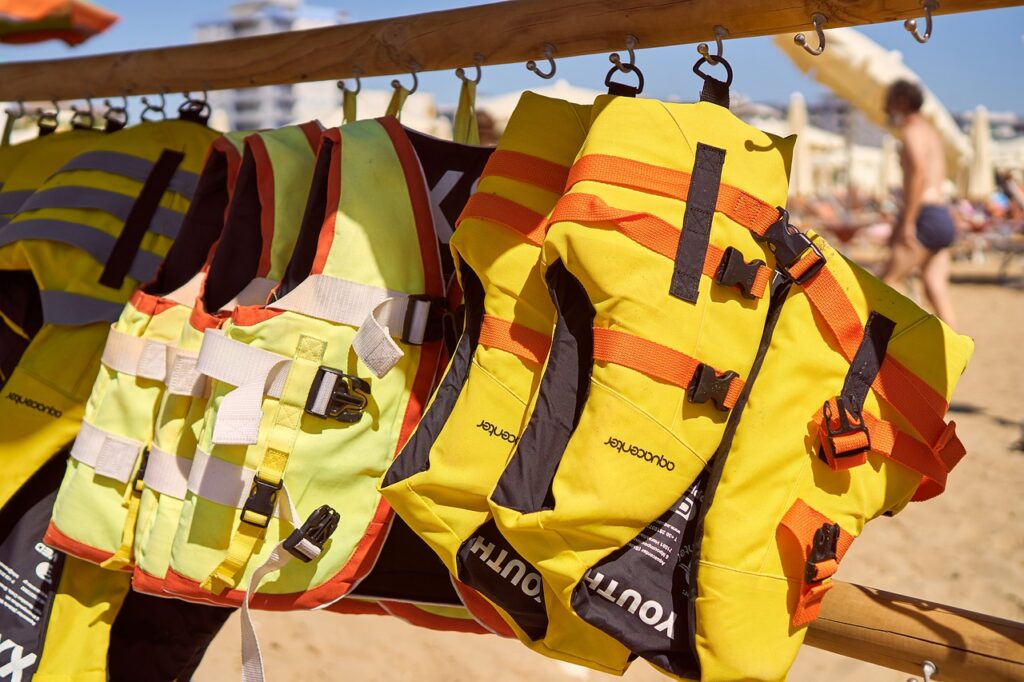
In my earlier post, I have discussed about the kayaking mistakes and how to fix them. Amongst the common kayaking mistakes, I would like to highlight some fundamental safety measures which can exactly be applied for canoeing.
Firstly, we must put on Personal Flotation Device (“PFD”), aka life jacket. In fact, apart from kayaking and canoeing, PFD is a must for ALL water sports, albeit PFD might not be enforced as part of safety measures.
Also, for beginners, we must not paddle too far away from the dock or the shore. Think about it, in the event of capsizing, nobody will notice if you are out of the vision.
Of course, the requirement for gears and equipment for kayaking can also be applied for canoeing. For example, we wear for the water, not for the weather; we wear sunglass to protect our eyes from the glaring sunlight……
2.3 Number of paddlers of kayaking and canoeing
In my opinion, both kayaking and canoeing are TWINS. Both can have 1, 2, and 4 paddlers. – Literally they are mirrored to each other.
No wonder they are under the Canoe Sprint discipline in the international competition. Alphabet “C” or “K” and number are used to differentiate them. – This method of classification is adopted by the International Canoe Federation.
C represents Canoe whereas K represents Kayak. Number represents the number of paddlers. For example, C1 means solo canoeing, or K4 means 4-paddler team kayaking.
So, the widely used categories are C1, C2, C4, K1, K2 and K4 in the Canoe Sprint competition.
Final thought
Kayaking and canoeing have a wonderful relationship with each other. They may look different to each other, but essentially, they are similar.
By looking at the differences, kayaking and canoeing have their own strength and weakness. For example, kayaking generally is faster than canoeing. But, canoeing generally is more suitable for family bonding.
So, when it comes to choosing which one is better for you, then you need to look at the differences and the purpose.
After all, they both are great recreational activities. You might even try both and fall in love with both kayaking and canoeing!
Relevant posts:
